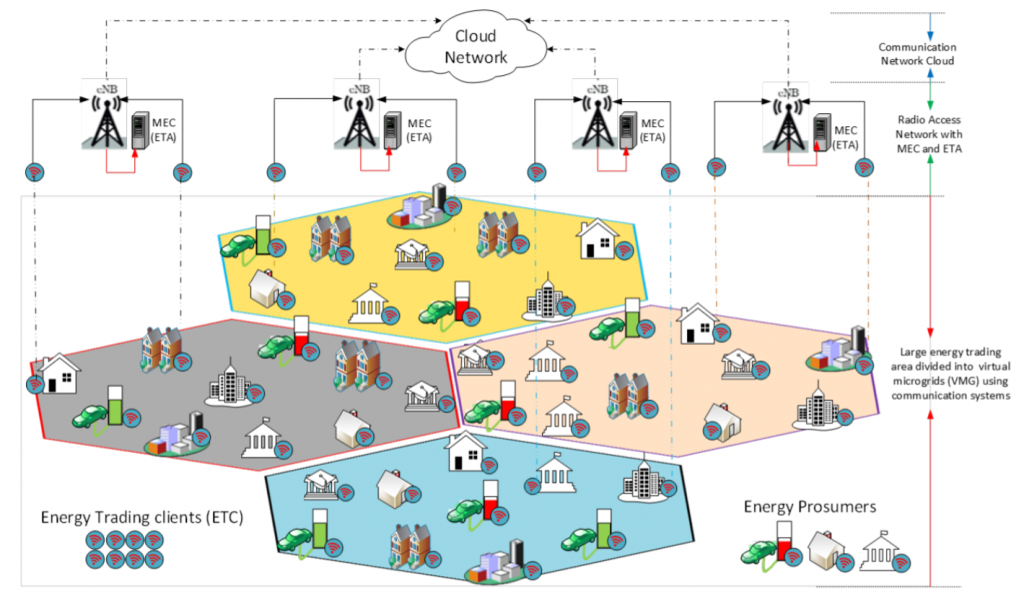By Kelvin Anoh
Microgrids are smart technology concepts develop to secure power distribution network and to ensure consistent energy delivery services to energy consumers. On the other hand, virtual microgrid is borne out the fourth industrial revolution (industry 4.0) concept towards digitising and cyber-networking of the energy infrastructures. While microgrids are made up of physical interconnectivity of energy consumers to the main grid, virtual microgrids are made up of energy prosumers that are logically connected to the communication infrastructure, themselves and the energy networks are the edges of the main grids.
The foremost of the virtual microgrid concept was introduced at a conference in Middle East University, Jordan in 2018 [1]. Since then, the virtual microgrid concept was later popularised in another journal paper presented at IEEE Transactions on Smart Grid [2].

As shown in Figure 1, the virtual microgrid involves the clustering of energy prosumers into groups of peers pursuing own selfish goal. The prosumers are only networked in such a way that they are allowed to trade among other peers within the same energy trading cluster.
The reason for the clustering is to reduce non-commodity charges as the charges become distributed among the energy prosumers existing in the network at any given time.
Prosumers connect within the network using energy trading client devices. These energy trading clients of one cluster communicate with the energy trading agent which maintains the energy trading information of the prevailing cluster. The prosumers may be equipped with electric vehicles, storage systems, distributed energy generators, etc.
The benefits of clustering the energy prosumers into groups of peers is to globally reduce non-commodity costs, power loss due to long distance transmission and to reduce greenhouse gases emission. On the communications side, by grouping the energy prosumers into clusters reduces communication delay, increases throughput and removes the burden of contacting the core network for local trading information. Energy trading information of any given prosumers can be stored in the cloud. Depending on the security and privacy instructions, the data generating from the trading history of the energy prosumers can be used to predict, manage and support the energy demand and consumption behaviour of the energy community.
How Does Virtual Microgrid Benefit You and Your Business
From the foregoing discussion, it is easy to envisage how the virtual microgrid technology could benefit you. For example, by introducing smart metering systems and network, you can remotely monitor your business – for example energy consumption of a cluster that your company supplies energy. In addition, you could deploy data analytics tools to evaluate the performances of the cluster over time. This would help in planning and budgeting for your business. The virtual microgrid concept could help one to predict total energy consumption of own business such that the excess of the energy could be sold to external companies or retailers including the main grid.
If these sound interesting to you, your business or someone that you know, kindly get in touch and we would be able to work with you to achieve the implementation and integration of the model into your business.
References
[1] K. Anoh, A. Ikpehai, D. Bajovic, O. Jogunola, B. Adebisi, D. Vukobratovic and M. Hammoudeh, “Virtual Microgrids: A Management Concept for Peer-to-Peer Energy Trading,” in the 2nd International Conference on Future Networks & Distributed Systems, Jordan, 10.1145/3231053.3231096
[2] K. Anoh, S. Maharjan, A. Ikpehai, Y. Zhang and B. Adebisi, “Energy Peer-to-Peer Trading in Virtual Microgrids in Smart Grids: A Game-Theoretic Approach,” in IEEE Transactions on Smart Grid, vol. 11, no. 2, pp. 1264-1275, March 2020, doi: 10.1109/TSG.2019.2934830.